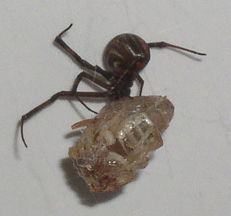|
This photograph of a black widow wrapping up her scorpion dinner was taken by Jennifer Williams. Desert Duets: Black Widow Spider Info Web Page Information about Black Widow Spiders Male black widow spiders beware! This species of spider gets its name from the fact that the female black widow spider occasionally eats the male after mating. She makes herself a widow. Although they are not the only "cannibal" arachnids, who eat their own kind, they are certainly the most famous for this behavior. Black widow spiders are not only dangerous to each other. They are the most poisonous spider in North America. The venom of the female black widow spider is 15 times more toxic than that of the prairie rattlesnake, but the spider will bite only when her web is disturbed. Adult males and all spiderlings are not dangerous to humans. The female black widow is twice as big as the male and weighs about twice as much. Both have shiny black (or dark brown) bodies, but only the female has the distinctive red hourglass shape on her abdomen. Males and spiderlings usually have yellow or red bands or spots on their backs. Unlike other spiders, black widows spin irregular,
messy webs. Their rough, sticky web silk is stronger
than that of most arachnids. They build their webs under rocks, ledges,
wood and other debris. They have oil on their legs that keep them from
getting tangled in their own webs. When insects
such as beetles, caterpillars, or flies get caught in the black widow's
web, she uses her fangs to puncture a hole in the prey. Then, she injects
a fluid that turns the insect's organs into liquid that she sucks out
of its body. Adult males wander in search of females but they do not
feed or bite. Black Widow Spider Pages: Home | Information | Babies | Activity | Resources |
